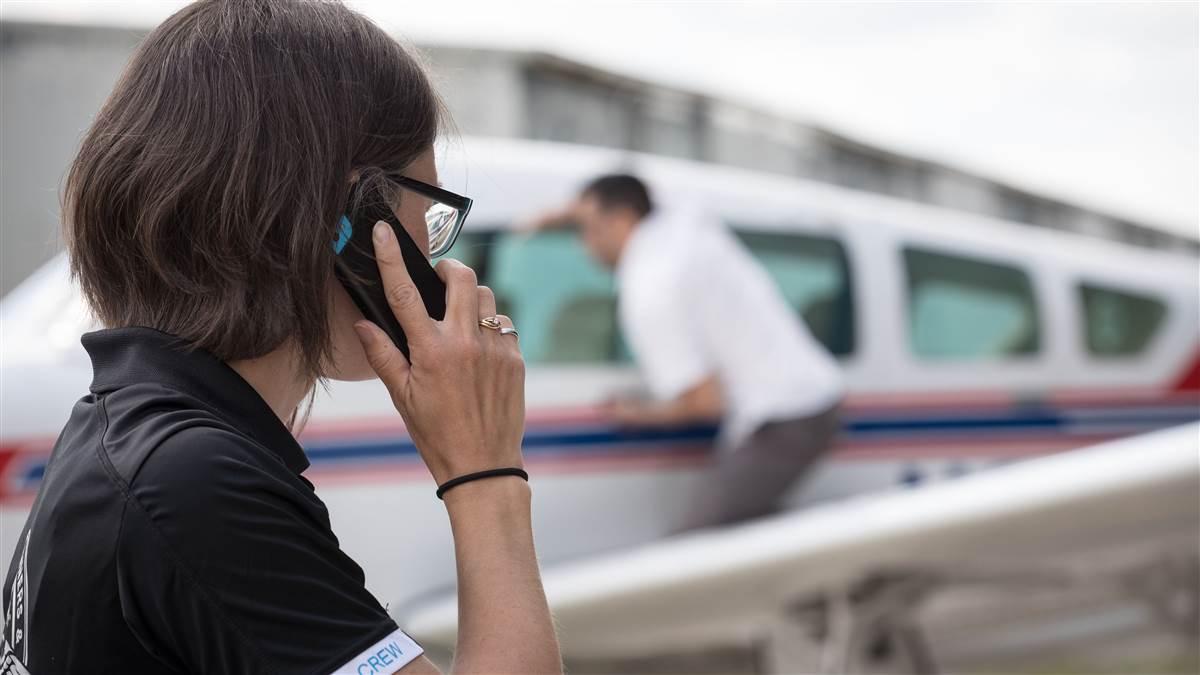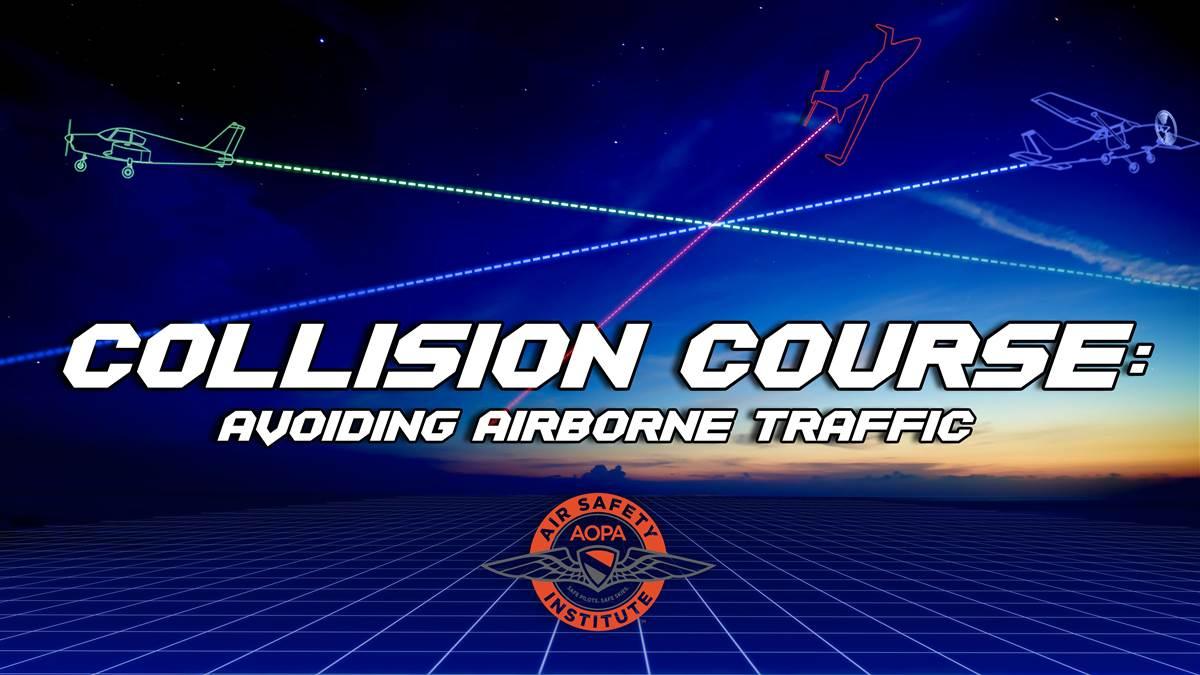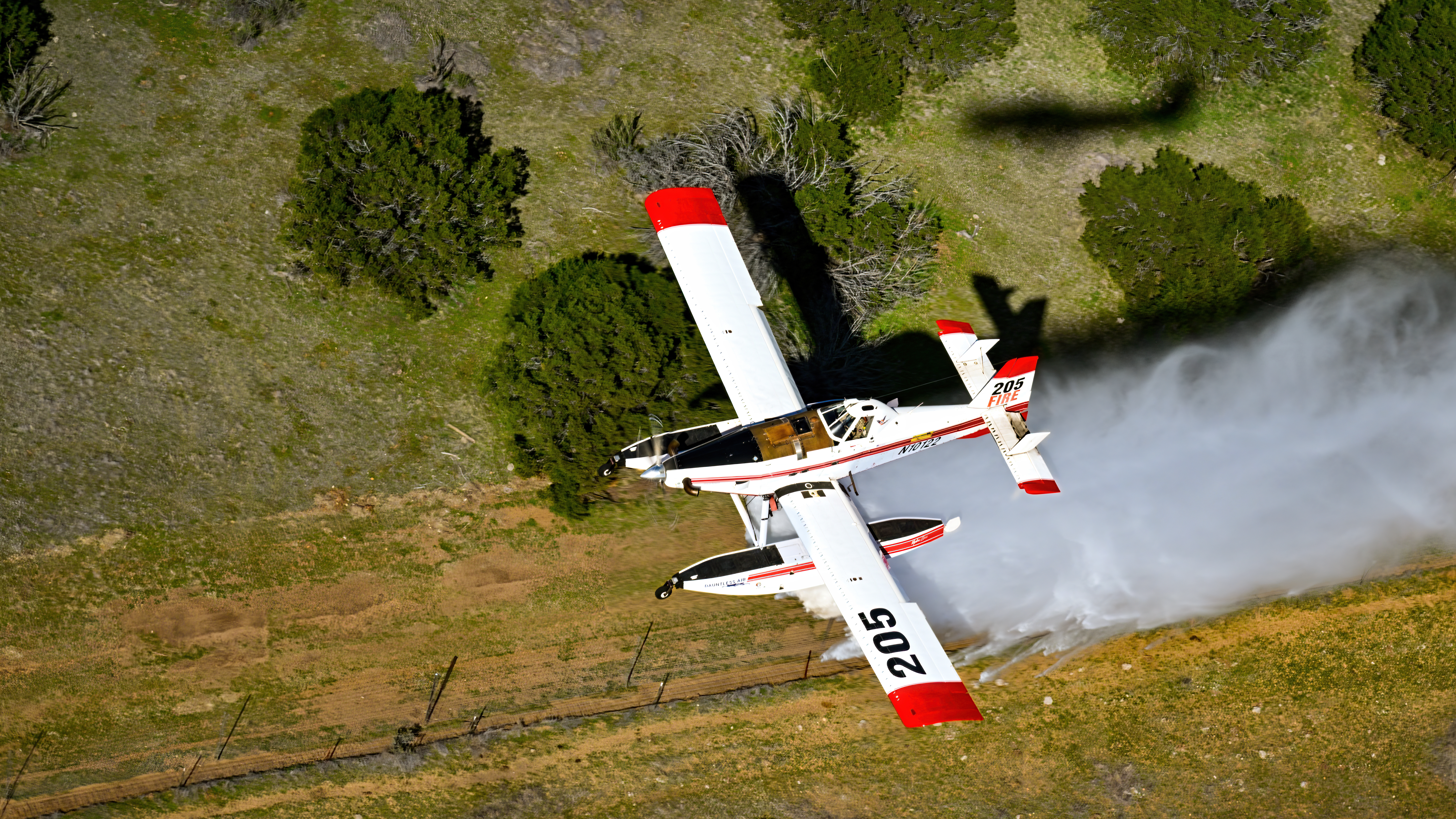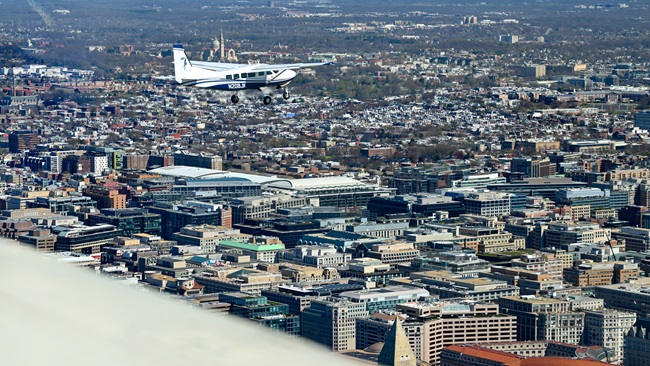Membership News & Notes
Touchdown in Tampa
By Thomas A. Horne
A just-right 78-degree temperature, 59-percent humidity, and four-knot winds greeted the first arrivals at the AOPA Fly-In at Tampa, Florida, presented by Peter O. Knight Airport.

The unusually mild and dry conditions were perfect for the estimated 5,478 attendees—339 of whom flew in.
Some 2,400 attendees arrived on Friday, where workshop sessions, proved especially popular. John Creedon, owner of a Piper Comanche 260, said this event was his first-ever regional fly-in, and that the entire event had a friendly atmosphere. “I came for the IFR Refresher workshop on Friday and the ADS-B seminar on Saturday,” he said. “I learned a lot and really appreciated the great work by the AOPA staff,” he said.
Front and center on the fly-in flight line was a brand-new Waco YMF–5F on amphibious floats. Waco Aircraft President Peter Bowers said the airplane should get its FAA certification by March 2018.
Additional aircraft on display included a Tecnam P2006T Rotax-powered twin, an AirCam, a Mooney Ovation Ultra, the Veterans Airlift Command’s Eclipse 500, a Cirrus SF50 Vision Jet, a Diamond DA42–VI, a Cessna TTx, and a TBM 930, among others. Even the late astronaut John Glenn’s 1981 Beechcraft Baron B58 was there. The Icon A5 also was prominent, with Icon Aircraft’s Tampa facility located on the field. Meanwhile, 57 exhibitors showed off their wares in Icon’s hangar.
The aircraft camping area at the airport may have been the most picturesque yet for an AOPA Fly-In. Camping was right along the water, with a view of the Tampa skyline in the distance. Chuck and Rhonda Stevens, who keep their Piper Warrior at Johnston County Airport in Smithfield, North Carolina, enjoyed the view from their tent.
The fly-in closed with a Pilot Town Hall in the main stage hangar. There, AOPA President and CEO Mark Baker and AOPA senior staffers reviewed AOPA’s principal political and other goals. The emphasis was on preventing so-called ATC privatization, an effort that requires us all to “keep up the pressure” on Congress, according to Jim Coon, AOPA senior vice president of government affairs and advocacy.
Baker updated the audience on egregious pricing by certain fixed-base operators, reporting that AOPA had received some 800 member complaints about exorbitant ramp and other fees. Those complaints have helped AOPA identify problem FBOs and focus its efforts to ensure fair pricing and access for general aviation pilots. Among other recent efforts, the association has filed FAR Part 13 complaints about three locations where FBOs have used their monopoly position to chart egregious fees.
Wrapping up the day was the traditional award to the pilot who flew the farthest to attend the fly-in. The award went to James McCague, who flew his Cessna 182 983 nautical miles from his base at Alliston Airport in Ontario, Canada. The prize? A Stratus ADS-B receiver manufactured by Appareo.
Email [email protected]
Member Services
Tips from PIC
Usage in the U.S. and neighboring countries
By Kathy Dondzila
Members sometimes call the AOPA Pilot Information Center to inquire about the necessity for 406-MHz emergency locator transmitter (ELT) equipage in countries other than the United States.
First, let’s clarify the situation in the United States. On February 1, 2009, the international COSPAS-SARSAT satellite system discontinued satellite-based monitoring of the 121.5/243-MHz frequencies, in part because of a high number of false signals associated with these frequencies. There’s no requirement in the United States to replace the first- and second-generation 121.5-MHz ELTs, but since that date, 121.5/243-MHz distress signals transmitted from ELTs operating on the lower frequency are only detected by ground-based receivers or by overflying aircraft. Although 121.5-MHz ELTs are still legal, they provide limited assistance if an aircraft crashes, especially in a remote location. AOPA opposes any attempt to mandate the replacement of existing 121.5/243-MHz ELTs with 406-MHz units, but the association encourages the installation of the more advanced ELTs on a voluntary basis.
When it comes to flying in neighboring and nearby countries, the International Civil Aviation Organization requires aircraft operated on long-range, overwater flights, or flights over designated land areas, to be equipped with ELTs that transmit simultaneously on 121.5 MHz and 406 MHz and feature an automatic activation function on at least one of the installed ELTs. To date, the United States, the Bahamas, and the Cayman Islands have waived this requirement. Check with other Caribbean destinations for the 406 requirements as part of your flight planning process. In Canada, as in the United States, you can fly with either type of ELT. Mexico continues to extend the compliance deadline for installing 406 MHz ELTs, with the current date set at June 30, 2018, for piston-powered, privately owned aircraft with a maximum takeoff weight of less than 12,566 pounds.
Kathy Dondzila is AOPA technical communications manager and an instrument-rated private pilot.Questions? Call the AOPA Pilot Information Center Monday through Friday, 8:30 a.m to 6 pm. 800-USA-AOPA (872-2672).
Pilot Protection Services
Legally speaking: BasicMed expiration dates
Pilots must pay careful attention to when the different components of BasicMed lapse and must be completed again. For an airman to act as pilot in command under BasicMed rules, within the previous 48 months he or she must have received a physical examination by a state-licensed physician who followed and completed the FAA’s comprehensive medical examination checklist, while the airman must have completed the online course within the previous 24 calendar months.
When the FAA Extension, Safety, and Security Act of 2016 (FESSA)—which contained BasicMed—was signed into law, the FAA incorporated the requirements of FESSA into the federal aviation regulations. This involved changes to Part 61, including FAR 61.23(c)(3)(i)(C) and 61.23(c)(3)(i)(D), as well as the inclusion of the new Part 68. Additional FAA guidance on the new regulations is available in Advisory Circular 68-1A. To ensure uninterrupted compliance with BasicMed, pilots must complete the required comprehensive medical examination and online medical education course within the required and differently calculated time periods.
For example, an airman who completed the BasicMed checklist and physical exam on May 10, 2017, and the online course on May 20, 2017, would be able to operate under BasicMed through May 31, 2019 (24 calendar months after the online course was completed). If the airman then completes the online course again on May 31, 2019, then he or she would be able to continue operating under BasicMed until May 10, 2021 (not May 31, 2021), because 48 months have passed since the physical exam.
Completing a new checklist and exam on May 11, 2021, would allow the pilot to operate under BasicMed until May 31, 2021, at which time another online course would be required. It would be advisable to set smartphone or other calendar reminders to keep the applicable expiration days straight.
For more on BasicMed, see AOPA’s Fit to Fly pilot resources.
Chad Mayer is an in-house attorney with AOPA’s Legal Services Plan. He is also a commercial pilot, a remote pilot with sUAS rating, and an advanced/instrument ground instructor.
AIR SAFETY INSTITUTE
ASI News
Do your part
Help safeguard our airports and aircraft
By Machteld Smith
 We like to think that it can’t happen at our airport, but unfortunately there are individuals who try to unlawfully gain access to airport property or aircraft. It’s not always immediately clear that these people have bad intentions. They may drive a nice car, be well-dressed, and not act threatening. But we must be vigilant for anyone who tries to falsely present him- or herself as a passenger, employee, or crewmember, or who attempts to gather passenger and aircraft data. As members of the general aviation community, we must help ensure the safety and security of our airports and aircraft. This means we take ownership of the situation.
We like to think that it can’t happen at our airport, but unfortunately there are individuals who try to unlawfully gain access to airport property or aircraft. It’s not always immediately clear that these people have bad intentions. They may drive a nice car, be well-dressed, and not act threatening. But we must be vigilant for anyone who tries to falsely present him- or herself as a passenger, employee, or crewmember, or who attempts to gather passenger and aircraft data. As members of the general aviation community, we must help ensure the safety and security of our airports and aircraft. This means we take ownership of the situation.
Shortly after the terrorist attacks of September 11, 2001, AOPA’s Airport Watch program and the Transportation Security Administration (TSA) teamed up to develop a curriculum that would help the general aviation community tap into resources to thwart security breaches at our airports.
The General Aviation Security Course, which was recently updated with refreshed content, can now be delivered to your desktop, laptop, and mobile devices. The interactive course offers practical guidance to limit opportunities for criminals or potential terrorists seeking access to aircraft at airports, flight schools, flying clubs, and FBOs. It provides examples of suspicious activity at airports and ways to identify, confirm, and report such activity while staying safe.
GA airports and tenants vary by location and services offered, so the course covers topics that allow customization of the type of security practices that may be employed. You can select one of four tracks (flight schools, aircraft owners, renter pilots, and FBOs and flying clubs) to fit your individual training needs. The custom track for flight schools—and FBOs and flying clubs that have direct contact with flight students—includes the TSA’s annual initial and recurrent security awareness training.
Explore the course and learn how to prevent unauthorized access to hangars and aircraft.
Machteld Smith is an aviation technical writer for the AOPA Air Safety Institute.
New from ASI
 Don’t be on a collision courseThe risk of a collision increases when multiple aircraft converge near the same navaid or approach the same airport. And as advanced cockpit technology allows more precise course and altitude tracking, aircraft may converge in a smaller block of airspace. In spite of ATC support and in-cockpit traffic displays, midair collisions still make headlines and close calls still happen too frequently.
Don’t be on a collision courseThe risk of a collision increases when multiple aircraft converge near the same navaid or approach the same airport. And as advanced cockpit technology allows more precise course and altitude tracking, aircraft may converge in a smaller block of airspace. In spite of ATC support and in-cockpit traffic displays, midair collisions still make headlines and close calls still happen too frequently.
The AOPA Air Safety Institute’s new Collision Course: Avoiding Airborne Traffic seminar, which debuts January 10, looks at the problem from a risk-management perspective. The seminar identifies high-risk scenarios and locations, and then offers strategies for avoiding them. From congested corridors to frenetic fly-ins, the seminar leader will talk about eye limitations that affect the “see and avoid” philosophy, proven techniques on enhancing visual scan effectiveness, maximizing visibility to other aircraft, the promise and peril of cockpit technology, and “danger zones” you may not be aware of. Invite your friends and fellow pilots and plan to attend the seminar at a location near you (www.airsafetyinstitute.org/seminars).
Seminar made possible by the generous support of Joyce Gardella, in memory of Paul Gardella.
Distracted by glass?Fly along with the AOPA Air Safety Institute’s iPanel Pilot Safety Announcement, which takes a tongue-in-cheek look at the modern electronic cockpit’s endless opportunities for distraction. It’s a satirical reminder that aircraft are still aircraft and need a pilot mentally onboard.
Insurance Services
Denied!
Five reasons your aviation insurance claim was rejected
Every pilot’s bad dream of having an accident as pilot in command turns into a full-fledged nightmare thinking about their insurance claim being denied. First, the good news: This rarely happens. When you purchase insurance, you are signing a contract. If you abide by the contract, then the insurance carrier is obligated to adhere to the contract. Similarly, the purchaser (aircraft owner) must also follow the rules of the policy. Here are some reasons your aviation insurance policy may have an issue.
1. You fibbed on your application.
- Pilot hours. Insurance carriers must know how many hours you have in the airplane. This requirement isn’t to make things difficult, it is an effort to prevent a loss. So, if it’s only 10 hours, say so, and don’t round up.
- Home base. Don’t mark the application as Kansas when the airplane is in a hurricane area. Moreover, it’s generally not a problem if the airplane is on a grass strip, but tell your broker if it’s turf, not pavement.
- Losses or DUIs. When asked if you have had any accidents, incidents, claims, or DUIs within the past five years, and you say “no,” but the answer is really “yes,” the insurance company may investigate. If it turns out you omitted this information, your claim could have an issue or your policy may be cancelled.
- Flying backwards. An update to an insurance policy suddenly goes backwards, say starting at 500 total hours in year one, but now in year two, it’s down to 300. Small differences in estimations are fine, and increases when you “audit” your logbook are also expected, but when pilots reduce hours by a significant amount, it’s called “flying backwards” and carriers might not offer renewal terms. They deem a significant reduction in hours a red flag. What’s the largest drop I’ve ever seen? Somewhere in the neighborhood of 800 hours.
2. Your airplane is out of annual. Here’s an insider’s tip: If your airplane is out of annual for a few days, when an accident occurs and you make a claim, the insurance company may honor your claim. But when those few days turn into a few months, or a few years, that’s grounds for a problem.
3. You’re out of currency. You must keep up your flight reviews, and medical (or BasicMed, if approved by your carrier). If one of those gets skewed, your claim may be denied.
4. You violate the open pilot warranty. Your insurance policy is written to cover you and pilots like you, meaning those with similar pilot credentials (if you allow someone other than yourself to fly your airplane). Your claim may be denied if you let anyone fly your airplane who is not named on your policy or who does not clearly meet your open pilot warranty.
5. Your aircraft is being used for an unapproved activity. A great example of this is when a pilot purchases “pleasure and business” coverage (commonly known as “P&B”) when the aircraft is purchased for personal transportation and then the pilot uses it for other purposes such as freelance flight instruction or aerial photography. An accident while performing an unapproved activity is the most frequent cause for a denial of coverage.
All insurance carriers ask for is an honest, wholehearted effort to follow the contract. Are there times when a pilot violated a small term of the agreement and the claim was still paid? Yes, but I wouldn’t bet on that happening every time.
Jim Pinegar is vice president of AOPA Insurance Services.


